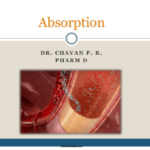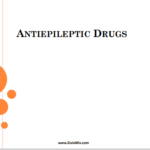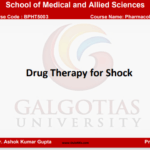BIOPHARMACEUTIC CONSIDERATIONS IN
DRUG PRODUCT DESIGN AND IN VITRO
DRUG PRODUCT PERFORMANCE
M.Pharm 2nd SEM
Dept.of Pharmaceutics
www.DuloMix.com 1
Contents:
Introduction to Bioavailability.
Methods of Assessing Bioavailability.
www.DuloMix.com 2
Introduction
A multi source drug product is a drug product that contains
the same active drug substance in the same dosage form and
is marketed by more than one pharmaceutical manufacturer.
Single source drug products are drug products for which the
patent has not expired or has certain exclusivities, so that
only one manufacturer can make it. Single source drug
products are usually brand name (Innovator) drug products.
After the patent and other exclusivities for the brand-name
drug expires, a pharmaceutical firm may manufacture a
generic drug product that can be substituted for the branded
drug product.
www.DuloMix.com 3
Since the formulation and the method of manufacture of the
drug product can affect the bioavailability and stability of the
drug, the generic drug manufacturer must demonstrate that the
generic drug product is bioequivalent and therapeutically
equivalent to the brand name drug product.
The therapeutic effectiveness of a drug depends upon the ability
of the dosage form to deliver the medicament to its site of action
at a rate and amount sufficient to elicit the desired
pharmacological response.
www.DuloMix.com 4
Definition
Bioavailability is defined as the rate and extent to which
the active ingredient or active moiety is absorbed from a
drug product and becomes available at the site of action.
For drug products that are not intended to be absorbed
into the blood stream, bioavailability may be assessed by
measurements intended to reflect the rate and extent to
which the active ingredients or active moiety becomes
available at the site of action.
Relative bioavailability is the bioavailability of the drug
from a drug product as compared to a recognized standard.
Absolute bioavailability is, when the systemic availability
of a drug after extra vascular administration is compared to
IV dosing.
www.DuloMix.com 5
Purpose of Bioavailability studies
Bioavailability studies are performed for both approved active
drug ingredients and therapeutic moieties not yet approved for
marketing by the FDA.
The drug products must meet all applicable standards of
identity, strength, quality and purity. To ensure that these
standards are met, the FDA requires Bioavailability or
Pharmacokinetic studies for all drug products.
Essential Pharmacokinetic parameters, including the rate and
extent of systemic absorption, elimination half life and rates of
excretion and metabolism should be established after single
and multiple dose administration. Data from these in-vivo
bioavailability studies are important to establish recommended
dosage regimens and to support drug labeling.
www.DuloMix.com 6
In-vivo bioavailability studies are also performed for new
formulations of active drug ingredients or therapeutic moieties
that are approved for marketing.
The purpose of these studies is to determine the bioavailability
and to characterize the pharmacokinetics of the new formulations
or new dosage form. Bioavailability studies are used to define the
effect of changes in the physicochemical properties of the drug
substance and the effect of the drug product on the
pharmacokinetics of the drug.
Bioequivalence studies are also considered as performance
measures of the drug product in-vivo.
www.DuloMix.com 7
Objectives
Bioavailability studies are important in the:-
❖Primary stages of development of a suitable dosage form for
a new drug entity.
❖ Determination of influence of excipients, patient related
factors and possible interactions with other drug on the
efficacy of absorption.
❖ Development of new formulation of the existing drugs.
❖Control of quality of a drug product during the early stages
of marketing in order to determine the influence of
processing factors, storage and stability on drug absorption.
www.DuloMix.com 8
Factors influencing Drug absorption and Bioavailability;
The chain of events that occur following administration of a
solid dosage form until its absorption into systemic
circulation are as follows:
The process consists of four steps:-
Disintegration of the drug product
De-aggregation and subsequent release of the drug.
Dissolution of the drug in the aqueous fluid at the
absorption site.
Movement of the dissolved drug through the GI membrane
into systemic circulation and away from the absorption site.
www.DuloMix.com 9
▪ The rate at which the drug reaches the systemic circulation is
determined by the slowest of the various steps involved in the
sequence.
▪ Such a step is called as the rate determining or rate limiting
step.
www.DuloMix.com 10
Considerations in bioavailability study design:
The area under the drug concentration-time curve (AUC) is
used as the measure of the total amount of unaltered drug
that reaches the systemic circulation.
The AUC is depended on the total quantity of the available
drug,FDo divided by the elimination rate constant,k, and the
apparent volume of distribution,VD .F is the fraction of the
dose absorbed. After IV administration F is equal to
unity,because the entire dose enters the systemic circulation.
Therefore the drug is considered to be completely available
after IV administration. After oral administration of the
drug,F may vary from a value of 0 (no drug absorption) to
1.(Complete drug absorption)
www.DuloMix.com 11
Relative bioavailability
It is the bioavailability of the drug from a drug product as
compared to a recognized standard. Here the systemic
availability of a drug after oral administration is compared
with that of an oral standard of the same drug.
The relative bioavailability of two drug products given at the
same dosage levels and by the same route of administration
can be obtained using the following equation;
Relative Bioavailability = [AUC]A
[AUC]B
Where drug product B is the recognized reference standard.
This fraction maybe multiplied by 100 to give percent relative
availability.
It is used to characterize the absorption of a drug from its
formulation.
www.DuloMix.com 12
ABSOLUTE BIOAVAILABILITY:-
When the systemic availability of a drug after extra vascular
administration is compared to IV dosing, it is called Absolute
bioavailability. It is generally measured by comparing the
respective AUC’s after extravascular and IV administration. Its
determination is used to characterize a drug’s inherent
absorption properties from the EV site. Intravenous dose is
selected as a standard because the drug is administered directly
into the systemic circulation (100%Bioavailability) and avoids
absorption step. Intramuscular dose can also be taken as a
standard if the drug is poorly water soluble.
Absolute Bioavailability after oral drug administration using
plasma data can be determined as follows;
Absolute Bioavailability=F= [AUC]po/dose po
[AUC]iv/dose iv
It is denoted by F and is expressed as a fraction or as a percent
by multiplying F x100
www.DuloMix.com 13
Methods of assessing Bioavailability:-
The methods useful in quantitative evaluation of
bioavailability can broadly divided into two categories;
Pharmacokinetic methods
Pharmacodynamic methods.
Clinical observations and in-vitro studies may also used to
determine drug bioavailability from a drug product.
www.DuloMix.com 14
PHARMACOKINETIC METHODS
These are very widely used and based on the assumption
that the pharmacokinetic profile reflects the therapeutic
effectiveness of a drug. Thus these are indirect methods.
The two major pharmacokinetic methods are
Plasma level-time studies
Urinary excretion studies.
www.DuloMix.com 15
Plasma level-time studies.
It is also called as Plasma drug concentration.
It is the most reliable method and method of choice in
comparison to urine data. It is a direct and objective way to
determine systemic bioavailability.
The method is based on the assumption that two dosage
forms that exhibits super imposable plasma level-time profiles
in a group of subjects should result in identical therapeutic
activity.
www.DuloMix.com 16
The 3 parameters of plasma level-time studies which are
considered important for determining bioavailability are;
Cmax
The peak plasma drug concentration, Cmax represents the
maximum plasma drug concentration obtained after oral
administration. This gives an indication whether the drug is
sufficiently absorbed systemically to provide a therapeutic
response. In addition it provides warning of possible toxic
levels of drugs. The units of Cmax are concentration units
(eg;mg/ml, ng/ml)
tmax
The peak time or time of peak plasma concentration, tmax
corresponds to the time required to reach maximum drug
concentration after drug administration. It gives an indication
of the rate of absorption. At tmax peak drug absorption occurs
and the rate of drug absorption exactly equals the rate of drug
elimination.Units for tmax are units of time (eg;hours,minutes)
www.DuloMix.com 17
PLASMA DRUG LEVEL-TIME CURVE
CMAX
P
L
A
S
M
A
C
O
N
C
tmax
Time
www.DuloMix.com 18
AUC
The area under the plasma level –time curve, AUC is a
measurement of the extent of drug bioavailability. It gives the
measure of the extent of absorption or the amount of the
drug that reaches the systemic circulation. The AUC is the
area under the drug plasma level time curve from t=0 to t=∞,
and is equal to the amount of unchanged drug reaching the
general circulation divided by the clearance.
[AUC] ∞
0 = FD0 = FD0
Clearance kVD
Where F =fraction of dose absorbed
D0 =Dose
k =elimination rate constant
VD = Volume of distribution.
The units of AUC are concentration time (eg;µg hr/ml)
www.DuloMix.com 19
RELATIONSHIP BETWEEN AUC AND
DOSE
AUC
AUC
Dose Dose
www.DuloMix.com 20
The extent of bioavailability can be determined by the
following equations;
F = [AUC]oral Div
[AUC]iv Doral
Fr = [AUC]test Dstd
[AUC]std Dtest
Bioavailability can also be determined from the peak plasma
concentration at steady state Css,max according to the
following equation.
Fr = (Css,max)test Dstd itest
(Css,max)std Dtest istd
www.DuloMix.com 21
URINARY EXCRETION STUDIES
It is an indirect method of estimating bioavailability.
This method is based on the principle that the urinary
excretion of the unchanged drug is directly proportional to
the plasma concentration of drug. Thus even if a drug is
excreted to some extent (atleast 10 to 20 %) in the urine
bioavailability can be determined.
Eg: Certain thiazide diuretics and sulphonamides have
urine as the site of action, such as nitrofurantoin and
hexamine.
Timely urine samples must be collected and the total
amount of urinary drug excretion must be obtained.
www.DuloMix.com 22
The 3 major parameters examined in urinary excretion data are ;
Xu
The cumulative amount of drug excreted in the urine, Xu is
related directly to the total amount of drug absorbed. It is also
related to the AUC of plasma level data and increases as the
extent of absorption increases.
Experimentally, urine samples are collected periodically after
administration of a drug product. Each urine specimen is
analyzed for free drug using a specific assay. A graph is
constructed that relates the cumulative drug excreted to the
collection time interval. When the drug is almost completely
eliminated,(Point C), the plasma concentration approaches 0
and the maximum amount of drug excreted in the urine Xu is
obtained.
www.DuloMix.com 23
(dXu/dt)max
The maximum urinary excretion rate, it is obtained from the
peak of plot between rate of excretion versus midpoint time of
urine collection period. It is analogous to the Cmax derived
from plasma level studies since the rate of appearance of drug
in the urine is proportional to its concentration in systemic
circulation. Its value increases as the rate of and /or extent of
absorption increases.
(tu)max
The time for maximum excretion rate, it is analogous to the
tmax of the plasma level data. Its value decreases as the
absorption rate increases.
www.DuloMix.com 24
URINARY EXCRETION STUDIES
(dxu/dt)max
E
X
C
R
E
T
I
O
N
(Tu)max
URINE COLLECTION PERIOD
www.DuloMix.com 25
The extent of bioavailability is calculated from the following
equations;
F = (Xu∞)oral Div
(Xu∞)iv Doral
With multiple dose study to steady state the equation for
computing the bioavailability is
Fr = (Xu,ss)test Dstd ƭtest
(Xu,ss)std Dtest ƭstd
Fr = (Xu ∞)test Dstd
(Xu∞)std Dtest
Where(Xu,ss) is the amount of drug excreted unchanged during a
single dosing interval at the steady state.
www.DuloMix.com 26
ADVANTAGES OF URINARY EXCRETION STUDIES
This method is useful when there is a lack of sufficiently
sensitive analytical technology to measure concentration of
drugs in plasma with accuracy.
Convenience of collecting urine samples.
Direct measurement of absolute and relative bioavailablity is
possible without the necessity of fitting the data to a
mathematic model.
When coupled with plasma level-time data,it can be used to
estimate renal clearance of unchanged drug,by
CLR=total amount of drug excreted unchanged / AUC
www.DuloMix.com 27
PHARMACODYNAMIC METHODS
These methods are complimentary to pharmacokintetic
approaches and involve direct measurement of drug effect on
a physiological process as a function of time.
The two pharmacodynamic methods involve determination
of bioavailability from;
a)Acute pharmacodynamic effect/acute pharmacological
response
b)Therapeutic response.
www.DuloMix.com 28
ACUTE PHARMACODYNAMIC EFFECT
When bioavailability measurement by pharmacokinetic
methods is difficult,inaccurate or non reproducible,acute
pharmacological effects such as change in ECG /EEG readings
,pupil diameter etc is related to the time course of a given drug.
Bioavailabitlity can be then determined by construction of
pharmacological effect –time curve as well as dose response
graphs.It is measured over the period of time after
administration of the drug product.The method requires
measurement of responses for atleast 3 biological half lives of
the drug in order to obtain a good estimate of AUC.
www.DuloMix.com 29
The use of pharmcodynamic end points for the determination
of bioavailability and bioequivalence is much more variable
than the measurement of plasma or urine drug concentration.
Disadvantage
Pharmacological response tends to be more variable and
accurate co-relation between measured response and drug
available from the formulation is difficult.
Moreover the observed response maybe due to an active
metabolite whose concentration is not proportional to the
concentration of parent drug responsible for pharmacological
effect.
www.DuloMix.com 30
THERAPEUTIC RESPONSE
This method is based on observing the clinical response to a drug
formulation given to patients suffering from disease for which it is
intended to be used.
Disadvantage
Quantification of observed response is too improper to allow for
reasonable assessment of relative bioavailability between two
dosage forms of the same drug.
www.DuloMix.com 31
References:
➢Biopharmaceutics and Pharmacokinetics-A
Treatise,By D M Brahmankar and Sunil B
Jaiswal,Second edition,page no-315 to 325.
➢Applied Biopharmaceutics and Pharmacokinetics by
Shargel L ,Andrew B C ,5th Edition.page no-453 to 464
www.DuloMix.com 32
THANK YOU
www.DuloMix.com 33










